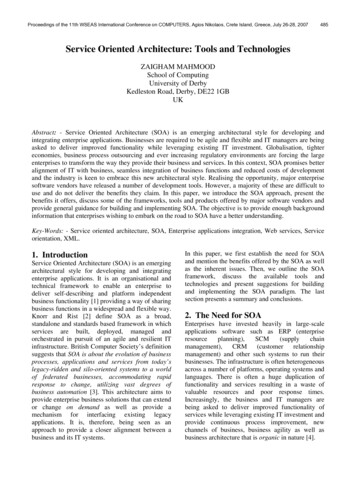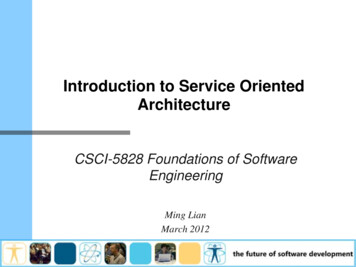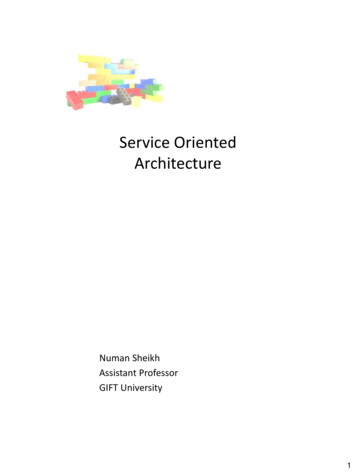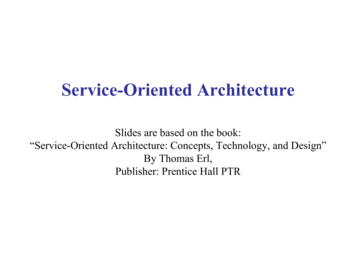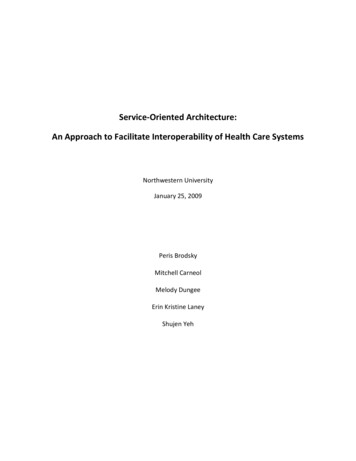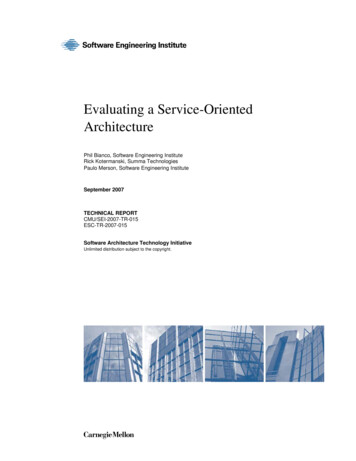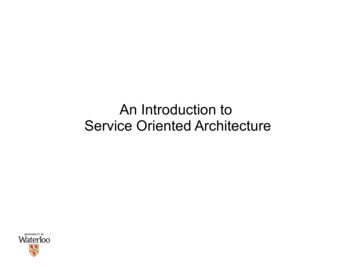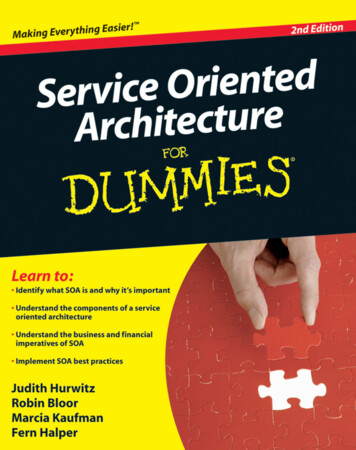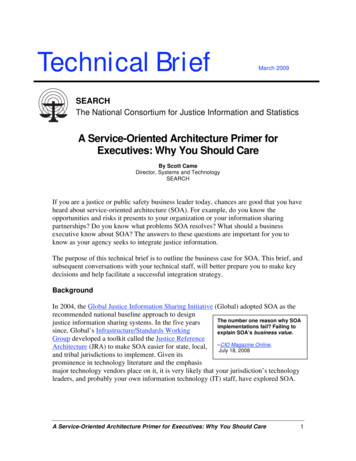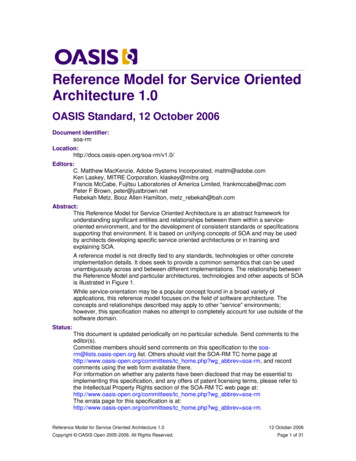
Transcription
Reference Model for Service OrientedArchitecture 1.0OASIS Standard, 12 October 2006Document rg/soa-rm/v1.0/Editors:C. Matthew MacKenzie, Adobe Systems Incorporated, mattm@adobe.comKen Laskey, MITRE Corporation, klaskey@mitre.orgFrancis McCabe, Fujitsu Laboratories of America Limited, frankmccabe@mac.comPeter F Brown, peter@justbrown.netRebekah Metz, Booz Allen Hamilton, metz rebekah@bah.comAbstract:This Reference Model for Service Oriented Architecture is an abstract framework forunderstanding significant entities and relationships between them within a serviceoriented environment, and for the development of consistent standards or specificationssupporting that environment. It is based on unifying concepts of SOA and may be usedby architects developing specific service oriented architectures or in training andexplaining SOA.A reference model is not directly tied to any standards, technologies or other concreteimplementation details. It does seek to provide a common semantics that can be usedunambiguously across and between different implementations. The relationship betweenthe Reference Model and particular architectures, technologies and other aspects of SOAis illustrated in Figure 1.While service-orientation may be a popular concept found in a broad variety ofapplications, this reference model focuses on the field of software architecture. Theconcepts and relationships described may apply to other "service" environments;however, this specification makes no attempt to completely account for use outside of thesoftware domain.Status:This document is updated periodically on no particular schedule. Send comments to theeditor(s).Committee members should send comments on this specification to the soarm@lists.oasis-open.org list. Others should visit the SOA-RM TC home page athttp://www.oasis-open.org/committees/tc home.php?wg abbrev soa-rm, and recordcomments using the web form available there.For information on whether any patents have been disclosed that may be essential toimplementing this specification, and any offers of patent licensing terms, please refer tothe Intellectual Property Rights section of the SOA-RM TC web page at:http://www.oasis-open.org/committees/tc home.php?wg abbrev soa-rmThe errata page for this specification is at:http://www.oasis-open.org/committees/tc home.php?wg abbrev soa-rm.Reference Model for Service Oriented Architecture 1.0Copyright OASIS Open 2005-2006. All Rights Reserved.12 October 2006Page 1 of 31
NoticesOASIS takes no position regarding the validity or scope of any intellectual property or other rightsthat might be claimed to pertain to the implementation or use of the technology described in thisdocument or the extent to which any license under such rights might or might not be available;neither does it represent that it has made any effort to identify any such rights. Information onOASIS's procedures with respect to rights in OASIS specifications can be found at the OASISwebsite. Copies of claims of rights made available for publication and any assurances of licensesto be made available, or the result of an attempt made to obtain a general license or permissionfor the use of such proprietary rights by implementers or users of this specification, can beobtained from the OASIS Executive Director.OASIS invites any interested party to bring to its attention any copyrights, patents or patentapplications, or other proprietary rights, which may cover technology that may be required toimplement this specification. Please address the information to the OASIS Executive Director.Copyright OASIS Open 2005-2006. All Rights Reserved.This document and translations of it may be copied and furnished to others, and derivative worksthat comment on or otherwise explain it or assist in its implementation may be prepared, copied,published and distributed, in whole or in part, without restriction of any kind, provided that theabove copyright notice and this paragraph are included on all such copies and derivative works.However, this document itself should not be modified in any way, such as by removing thecopyright notice or references to OASIS, except as needed for the purpose of developing OASISspecifications, in which case the procedures for copyrights defined in the OASIS IntellectualProperty Rights document must be followed, or as required to translate it into languages otherthan English.The limited permissions granted above are perpetual and will not be revoked by OASIS or itssuccessors or assigns.This document and the information contained herein is provided on an “AS IS” basis and OASISDISCLAIMS ALL WARRANTIES, EXPRESS OR IMPLIED, INCLUDING BUT NOT LIMITED TOANY WARRANTY THAT THE USE OF THE INFORMATION HEREIN WILL NOT INFRINGEANY RIGHTS OR ANY IMPLIED WARRANTIES OF MERCHANTABILITY OR FITNESS FOR APARTICULAR PURPOSE.Reference Model for Service Oriented Architecture 1.0Copyright OASIS Open 2005-2006. All Rights Reserved.12 October 2006Page 2 of 31
Table of Contents1Introduction. 41.1 What is a reference model . 41.2 A Reference Model for Service Oriented Architectures . 41.3 Audience . 51.4 Guide to using the reference model . 61.5 Notational Conventions . 61.5.1 How to interpret concept maps. . 61.6 Relationships to Other Standards . 72 Service Oriented Architecture . 82.1 What is Service Oriented Architecture? . 82.1.1 A worked Service Oriented Architecture example . 92.2 How is Service Oriented Architecture different? . 102.3 The Benefits of Service Oriented Architecture. 113 The Reference Model. 123.1 Service . 123.2 Dynamics of Services. 133.2.1 Visibility . 133.2.2 Interacting with services . 153.2.3 Real World Effect . 183.3 About services. 193.3.1 Service description. 203.3.2 Policies and Contracts . 223.3.3 Execution context. 244 Conformance Guidelines. 265 References . 275.1 Normative . 275.2 Non-Normative . 27A. Glossary. 28B. Acknowledgments. 31Reference Model for Service Oriented Architecture 1.0Copyright OASIS Open 2005-2006. All Rights Reserved.12 October 2006Page 3 of 31
11 Introduction234567The notion of Service Oriented Architecture (SOA) has received significant attention within thesoftware design and development community. The result of this attention is the proliferation ofmany conflicting definitions of SOA. Whereas SOA architectural patterns (or referencearchitectures) may be developed to explain and underpin a generic design template supporting aspecific SOA, a reference model is intended to provide an even higher level of commonality, withdefinitions that should apply to all SOA.81.1 What is a reference model91011121314A reference model is an abstract framework for understanding significant relationships amongthe entities of some environment. It enables the development of specific reference or concretearchitectures using consistent standards or specifications supporting that environment. Areference model consists of a minimal set of unifying concepts, axioms and relationships within aparticular problem domain, and is independent of specific standards, technologies,implementations, or other concrete details.15161718192021As an illustration of the relationship between a reference model and the architectures that canderive from such a model, consider what might be involved in modeling what is important aboutresidential housing. In the context of a reference model, we know that concepts such as eatingareas, hygiene areas and sleeping areas are all important in understanding what goes into ahouse. There are relationships between these concepts, and constraints on how they areimplemented. For example, there may be physical separation between eating areas and hygieneareas.222324252627The role of a reference architecture for housing would be to identify abstract solutions to theproblems of providing housing. A general pattern for housing, one that addresses the needs of itsoccupants in the sense of, say, noting that there are bedrooms, kitchens, hallways, and so on is agood basis for an abstract reference architecture. The concept of eating area is a referencemodel concept, a kitchen is a realization of eating area in the context of the referencearchitecture.282930313233There may be more than one reference architecture that addresses how to design housing; forexample, there may be a reference architecture to address the requirements for developinghousing solutions in large apartment complexes, another to address suburban single familyhouses, and another for space stations. In the context of high density housing, there may not bea separate kitchen but rather a shared cooking space or even a communal kitchen used by manyfamilies.34353637An actual – or concrete – architecture would introduce additional elements. It would incorporateparticular architectural styles, particular arrangements of windows, construction materials to beused and so on. A blueprint of a particular house represents a specific architecture as it applies toa proposed or actually constructed dwelling.38394041The reference model for housing is, therefore, at least three levels of abstraction away from aphysical entity that can be lived in. The purpose of a reference model is to provide a commonconceptual framework that can be used consistently across and between differentimplementations and is of particular use in modeling specific solutions.421.2 A Reference Model for Service Oriented Architectures43444546The goal of this reference model is to define the essence of service oriented architecture, andemerge with a vocabulary and a common understanding of SOA. It provides a normativereference that remains relevant for SOA as an abstract and powerful model, irrespective of thevarious and inevitable technology evolutions that will influence SOA deployment.Reference Model for Service Oriented Architecture 1.0Copyright OASIS Open 2005-2006. All Rights Reserved.12 October 2006Page 4 of 31
474849505152Figure 1 shows how a reference model for SOA relates to other distributed systems architecturalinputs. The concepts and relationships defined by the reference model are intended to be thebasis for describing references architectures and patterns that will define more specific categoriesof SOA designs. Concrete architectures arise from a combination of reference architectures,architectural patterns and additional requirements, including those imposed by technologyenvironments.535455Architecture must account for the goals, motivation, and requirements that define the actualproblems being addressed. While reference architectures can form the basis of classes ofsolutions, concrete architectures will define specific solution approaches.5657Architecture is often developed in the context of a pre-defined environment, such as theprotocols, profiles, specifications, and standards that are pertinent.585960SOA implementations combine all of these elements, from the more generic architecturalprinciples and infrastructure to the specifics that define the current needs, and represent specificimplementations that will be built and used in an operational environment.6162Figure 1 How the Reference Model relates to other work631.3 Audience64The intended audiences of this document include non-exhaustively:6566676869707172 Architects and developers designing, identifying or developing a system based on theservice-oriented paradigm.Standards architects and analysts developing specifications that rely on service orientedarchitecture concepts.Decision makers seeking a "consistent and common" understanding of service orientedarchitectures.Users who need a better understanding of the concepts and benefits of service orientedarchitecture.Reference Model for Service Oriented Architecture 1.0Copyright OASIS Open 2005-2006. All Rights Reserved.12 October 2006Page 5 of 31
731.4 Guide to using the reference model7475New readers are encouraged to read this reference model in its entirety. Concepts are presentedin an order that the authors hope promote rapid understanding.767778This section introduces the conventions, defines the audience and sets the stage for the rest ofthe document. Non-technical readers are encouraged to read this information as it providesbackground material necessary to understand the nature and usage of reference models.7980818283Section 2 introduces the concept of SOA and identifies some of the ways that it differs fromprevious paradigms for distributed systems. Section 2 offers guidance on the basic principles ofservice oriented architecture. This can be used by non-technical readers to gain an explicitunderstanding of the core principles of SOA and by architects as guidance for developing specificservice oriented architectures.848586878889Section 3 introduces the Reference Model for SOA. In any framework as rich as SOA, it is difficultto avoid a significant amount of cross referencing between concepts. This makes presentation ofthe material subject to a certain amount of arbitrariness. We resolve this by introducing theconcept of service itself, then we introduce concepts that relate to the dynamic aspects of serviceand finally we introduce those concepts that refer to the meta-level aspects of services such asservice description and policies as they apply to services.90Section 4 addresses compliance with this reference model.919293The glossary provides definitions of terms that are relied upon within the reference modelspecification but do not necessarily form part of the specification itself. Terms that are defined inthe glossary are marked in bold at their first occurrence in the document.9495969798Note that while the concepts and relationships described in this reference model may apply toother "service" environments, the definitions and descriptions contained herein focus on the fieldof software architecture and make no attempt to completely account for use outside of thesoftware domain. Examples included in this document that are taken from other domains areused strictly for illustrative purposes.991.5 Notational Conventions100101102The key words MUST, MUST NOT, REQUIRED, SHALL, SHALL NOT, SHOULD, SHOULD NOT,RECOMMENDED, MAY, and OPTIONAL in this document are to be interpreted as described in[RFC2119].103References are surrounded with [square brackets and are in bold text].1041.5.1 How to interpret concept maps.105106107Concepts maps are used within this document. There is no normative convention for interpretingConcept maps and other than described herein, no detailed information can be derived from theconcept maps herein.108109110111Figure 2 A basic concept map112113114115As used in this document a line between two concepts represents a relationship, where therelationship is not labeled but rather is described in the text immediately preceding or followingthe figure. The arrow on a line indicates an asymmetrical relationship, where the concept towhich the arrow points (Concept 2 in Figure 2) can be interpreted as depending in some way onReference Model for Service Oriented Architecture 1.0Copyright OASIS Open 2005-2006. All Rights Reserved.12 October 2006Page 6 of 31
116117the concept from which the line originates (Concept 1). The text accompanying each graphicdescribes the nature of each relationship.1181.6 Relationships to Other Standards119Due to its nature, this reference model may have an implied relationship with any group that:120 Considers its work "service oriented";121122 Makes (publicly) an adoption statement to use the Reference Model for SOA as a base orinspiration for their work; and123 Standards or technologies that claim to be service oriented.124125The reference model does not endorse any particular service-oriented architecture, or attest tothe validity of third party reference model conformance claims.Reference Model for Service Oriented Architecture 1.0Copyright OASIS Open 2005-2006. All Rights Reserved.12 October 2006Page 7 of 31
1262 Service Oriented Architecture1272.1 What is Service Oriented Architecture?128129Service Oriented Architecture (SOA) is a paradigm for organizing and utilizing distributedcapabilities that may be under the control of different ownership domains.130131132133In general, entities (people and organizations) create capabilities to solve or support a solution forthe problems they face in the course of their business. It is natural to think of one person’s needsbeing met by capabilities offered by someone else; or, in the world of distributed computing, onecomputer agent’s requirements being met by a computer agent belonging to a different owner.134135136137138There is not necessarily a one-to-one correlation between needs and capabilities; the granularityof needs and capabilities vary from fundamental to complex, and any given need may require thecombining of numerous capabilities while any single capability may address more than one need.The perceived value of SOA is that it provides a powerful framework for matching needs andcapabilities and for combining capabilities to address those needs.139140141142143144Visibil
42 1.2 A Reference Model for Service Oriented Architectures The goal of this reference model is to define the essence of service oriented architecture, and emerge with a vocabulary and a common understanding of SOA. It provides a normative reference that remains relevant for SOA as an abstract and powerful model, irrespective of the

